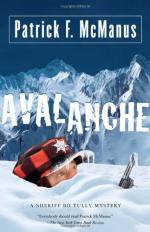|
This section contains 3,730 words (approx. 13 pages at 300 words per page) |

|
An avalanche is, at first glance, a very simple event. The term comes from an old French word, avalanste, which comes from avaler, meaning "to lower or let down." Basically, an avalanche is nothing more than the setting in motion of a large amount of temporarily stationary material that slides down a slope.
An avalanche can consist of solid material such as rocks, coal, or slag, the waste material from mining. In fact, such landslides are often the most destructive avalanches of all. In 1970 an earthquake triggered a gigantic rock avalanche in Peru, which claimed the lives of an estimated eighteen thousand people. Similarly, Canada's worst avalanche disaster came when ninety tons of limestone broke loose from the Turtle Mountains and destroyed the town of Frank, Alberta, killing ninety-five people.
But such disasters are freak accidents of nature or of human carelessness...
|
This section contains 3,730 words (approx. 13 pages at 300 words per page) |

|




